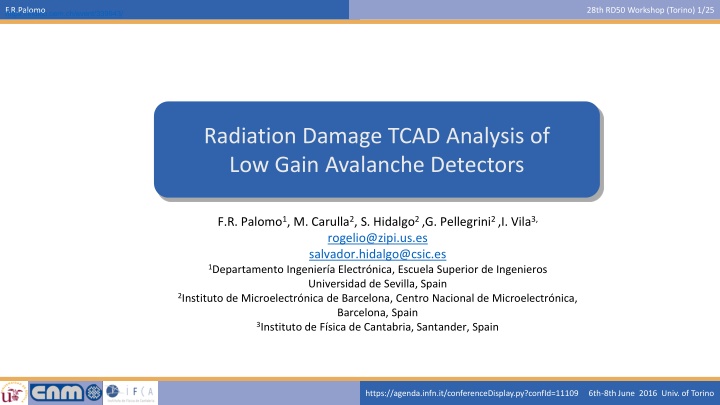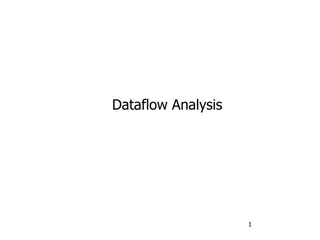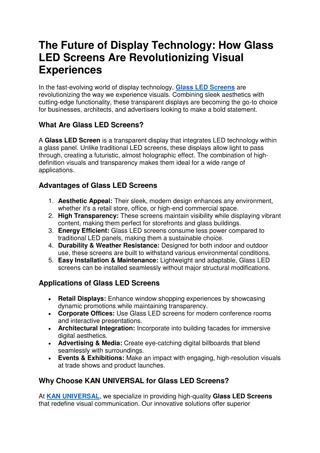
Radiation Damage TCAD Analysis in Low Gain Avalanche Detectors
Explore the Radiation Damage TCAD Analysis and Simulation in Low Gain Avalanche Detectors presented at the 28th RD50 Workshop in Torino. The study includes Sentaurus TCAD Simulation setups, LGAD bias analysis, and radiation damage models like the CMS Proton Model. Gain insight into the effects of radiation damage on silicon detectors in high fluence scenarios.
Download Presentation

Please find below an Image/Link to download the presentation.
The content on the website is provided AS IS for your information and personal use only. It may not be sold, licensed, or shared on other websites without obtaining consent from the author. If you encounter any issues during the download, it is possible that the publisher has removed the file from their server.
You are allowed to download the files provided on this website for personal or commercial use, subject to the condition that they are used lawfully. All files are the property of their respective owners.
The content on the website is provided AS IS for your information and personal use only. It may not be sold, licensed, or shared on other websites without obtaining consent from the author.
E N D
Presentation Transcript
F.R.Palomo https://indico.cern.ch/event/339943/ 28th RD50 Workshop (Torino) 1/25 Radiation Damage TCAD Analysis of Low Gain Avalanche Detectors F.R. Palomo1, M. Carulla2, S. Hidalgo2 ,G. Pellegrini2 ,I. Vila3, rogelio@zipi.us.es salvador.hidalgo@csic.es 1Departamento Ingenier a Electr nica, Escuela Superior de Ingenieros Universidad de Sevilla, Spain 2Instituto de Microelectr nica de Barcelona, Centro Nacional de Microelectr nica, Barcelona, Spain 3Instituto de F sica de Cantabria, Santander, Spain https://agenda.infn.it/conferenceDisplay.py?confId=11109 6th-8th June 2016 Univ. of Torino
F.R.Palomo https://indico.cern.ch/event/339943/ 28th RD50 Workshop (Torino) 2/25 Sentaurus TCAD Simulation SetUp Mixed Simulation Setup: Simulation Setup ReadOut Simulation Setup Red Pulsed Laser: 670 nm, 10 m spot, 1e4W/cm2, 50 ps, BackIllumination at Device Center ReadOut: gain unity current amplifier (Rf=1), AC (1 nF) coupled 2D detector model: 1 m in Z direction, 3 mm in X direction, 300 m in Y direction) Red Pulsed Laser z x y P-Stop Collector Ring C-Stop Low Gain Avalanche Detector (LGAD) cross-section Doping profiles under confidenciality rules https://agenda.infn.it/conferenceDisplay.py?confId=11109 6th-8th June 2016 Univ. of Torino
F.R.Palomo https://indico.cern.ch/event/339943/ 28th RD50 Workshop (Torino) 3/25 LGAD 5,52 4,88 4,26 LGAD current transient, variable bias & Total transient charge Gain=(QLGAD/QPiN )|bias LGAD Bias Analysis: 250V, 450V, 650V, Gain shows a linear increase with bias The equivalent PiN is an LGAD device without Pwell (gain well) https://agenda.infn.it/conferenceDisplay.py?confId=11109 6th-8th June 2016 Univ. of Torino
F.R.Palomo https://indico.cern.ch/event/339943/ 28th RD50 Workshop (Torino) 4/25 Radiation Damage Models CMS Proton Model Four damage models 1. Pennicard Model =1e12 up to 1e14 neq/cm2 2. CMS Proton and Neutron model = 1e14-1e15 neq/cm2 3. Delhi Model Proton = 1e14-1e15 neq/cm2 4. New Perugia Model =1e12 up to 2e16 neq/cm2 CMS Neutron Model Simulation of Silicon Devices for the CMS Phase II Tracker Upgrade CMS Note 250887 N(cm-3)= int x New Perugia Pennicard Model Simulations of radiation-damaged 3D detectors for the Super-LHC, D.Pennicard et al. NIMA 592(1-2), 2008, pp16-25 N(cm-3)=gint x Delhi Model Modeling of radiation damage effects in silicon detectors at high fluences HL-LHC with Sentaurus TCAD, D.Passeri et al, NIMA 824 (2016), 443-445 Combined effect of bulk and Surface damage on strip insulation properties of proton irradiated n+-p silicon strip sensors, R.Dalal et al. JINST 2014 9 P04007 https://agenda.infn.it/conferenceDisplay.py?confId=11109 6th-8th June 2016 Univ. of Torino
F.R.Palomo https://indico.cern.ch/event/339943/ 28th RD50 Workshop (Torino) 5/25 LGAD Pulsed red laser transient, current amp readout (gain=1) Pennicard Damage Model LGAD 400V Bias Fluence Gain Pennicard model valid up to 1e14 neq/cm2. It shows that LGAD does not experiment a significative gain reduction up to 1e14. At 1e14, gain decreases 29%. 0 4,80 1e12 4,72 1e13 4,54 1e14 3,36 ## Putting traps in Silicon region only ## Trap concentrations found from Petasecca model and modified by D. Pennicard, Fluence=1E14 Physics (material="Silicon") { # Putting traps in silicon region only # Modified Perugia model with trapping times at reported value Traps ( (Acceptor Level EnergyMid=0.42 fromCondBand Conc=1.1613E14 Randomize=0.29 eXsection=9.5E-15 hXsection=9.5E-14) #Conc=Fluence*1.1613 (Acceptor Level EnergyMid=0.46 fromCondBand Conc=0.9E14 Randomize=0.23 eXsection=5E-15 hXsection=5E-14 ) #Conc=Fluence*0.9 (Donor Level EnergyMid=0.36 fromValBand Conc=0.9E14 Randomize=0.31 eXsection=3.23E-13 hXsection=3.23E-14 ) #Conc=Fluence*0.9 ) } (Reference PiN Charge 50.9 fC) https://agenda.infn.it/conferenceDisplay.py?confId=11109 6th-8th June 2016 Univ. of Torino
F.R.Palomo https://indico.cern.ch/event/339943/ 28th RD50 Workshop (Torino) 6/25 LGAD Pulsed red laser transient, current amp readout (gain=1) CMS Neutron Damage Model Fluence Charge (fC) Gain 0 244,0 4,80 1e14 186,1 3,66 1e15 30,7 0,60 ## Putting traps in Silicon region only ## Trap concentrations found from CMS Two level neutrons #Fluence=1E14 Physics (material="Silicon") { # Putting traps in silicon region only Traps ( (Acceptor Level EnergyMid=0.525 fromCondBand Conc=1.55E14 eXsection=1.2E-14 hXsection=1.2E-14) (Donor Level EnergyMid=0.48 fromValBand Conc=1.395E14 eXsection=1.2E-14 hXsection=1.2E-14) ) } PIN DIODE Non Irradiated https://agenda.infn.it/conferenceDisplay.py?confId=11109 6th-8th June 2016 Univ. of Torino
F.R.Palomo https://indico.cern.ch/event/339943/ 28th RD50 Workshop (Torino) 7/25 LGAD Pulsed red laser transient, current amp readout (gain=1) CMS Proton Damage Model Fluence Charge (fC) Gain 0 244,0 4,80 1e14 186,7 3,67 1e15 24,6 0,48 ## Putting traps in Silicon region only ## Trap concentrations found from CMS Two level protons #Fluence=1E14 Physics (material="Silicon") { # Putting traps in silicon region only Traps ( (Acceptor Level EnergyMid=0.525 fromCondBand Conc=1.8344E14 eXsection=1E-14 hXsection=1E-14) (Donor Level EnergyMid=0.48 fromValBand Conc=1.6390E14 eXsection=1E-14 hXsection=1E-14) ) } PIN DIODE Non Irradiated https://agenda.infn.it/conferenceDisplay.py?confId=11109 6th-8th June 2016 Univ. of Torino
F.R.Palomo https://indico.cern.ch/event/339943/ 28th RD50 Workshop (Torino) 8/25 LGAD Pulsed red laser transient, current amp readout (gain=1) Delhi Damage Model Fluence Charge (fC) Gain 0 244,0 4,80 1e14 124,6 2,45 1e15 9,4 0,18 ## Putting traps in Silicon region only ## Trap concentrations found from Delhi Two level #Fluence=1E14 Physics (material="Silicon") { # Putting traps in silicon region only Traps ( (Acceptor Level EnergyMid=0.51 fromCondBand Conc=4E14 eXsection=2E-14 hXsection=3.8E-15) (Donor Level EnergyMid=0.48 fromValBand Conc=3E14 eXsection=2E-15 hXsection=2E-15) ) } PIN DIODE Non Irradiated https://agenda.infn.it/conferenceDisplay.py?confId=11109 6th-8th June 2016 Univ. of Torino
F.R.Palomo https://indico.cern.ch/event/339943/ 28th RD50 Workshop (Torino) 9/25 LGAD All Models show a similar panorama CMS Model Electric Field along Y axis 1e15 Back side detail Front side Back side Front side detail At 1e15 a double junction appears at P+ volumen (device back side) 1e15 Electric Field Profiling https://agenda.infn.it/conferenceDisplay.py?confId=11109 6th-8th June 2016 Univ. of Torino
F.R.Palomo https://indico.cern.ch/event/339943/ 28th RD50 Workshop (Torino) 10/25 LGAD Delhi Models Electric Field along Y axis Front side Back side detail 1e15 Back side Front side detail At 1e15 a double junction appears at P+ volume Electric Field Profiling 1e15 https://agenda.infn.it/conferenceDisplay.py?confId=11109 6th-8th June 2016 Univ. of Torino
F.R.Palomo https://indico.cern.ch/event/339943/ 28th RD50 Workshop (Torino) 11/25 LGAD7859D10-3 CV analysis 1. This LGAD is fully depleted past 70V 2. Capacitance shows a clear increase beyond 1e15 n/cm2 3. 1/C2 formula is not clear beyond 1e14 Now, we analyze a real device, the PAD LGAD7859D10-3 It has JTE s, 300 m thickness one extraction ring. CV Analysis with: 1. New Perugia Model: 1. Fresh 2. 1e13-1e14-1e15-7e15-2e16 n/cm2 2. Temperature = 20 C https://agenda.infn.it/conferenceDisplay.py?confId=11109 6th-8th June 2016 Univ. of Torino
F.R.Palomo https://indico.cern.ch/event/339943/ 28th RD50 Workshop (Torino) 12/25 LGAD7859D10-3 CV analysis IV Analysis with: 1. New Perugia Model: 1. Fresh 2. 1e13-1e14-1e15-7e15-2e16 n/cm2 2. Temperature = 20 C IV plots show problems starting at 1e15, the leakage grows a lot and even the general curve is different. This is coincident with the previous models. https://agenda.infn.it/conferenceDisplay.py?confId=11109 6th-8th June 2016 Univ. of Torino
F.R.Palomo https://indico.cern.ch/event/339943/ 28th RD50 Workshop (Torino) 13/25 LGAD7859D10-3 CV analysis IV Analysis with: 1. New Perugia Model: 1. Fresh 2. 1e13-1e14-1e15-7e15-2e16 n/cm2 2. Temperature = 20 C IV plots show problems starting at 1e15, the leakage grows a lot and even the general curve is different. This is coincident with the previous models. https://agenda.infn.it/conferenceDisplay.py?confId=11109 6th-8th June 2016 Univ. of Torino
F.R.Palomo https://indico.cern.ch/event/339943/ 28th RD50 Workshop (Torino) 14/25 LGAD7859D10-3 CV analysis IV Analysis with: 1. New Perugia Model: 1. Fresh 2. 1e13-1e14-1e15-7e15-2e16 n/cm2 2. Temperature = 20 C IV plots show problems starting at 1e15, the leakage grows a lot and even the general curve is different. This is coincident with the previous models. https://agenda.infn.it/conferenceDisplay.py?confId=11109 6th-8th June 2016 Univ. of Torino
F.R.Palomo https://indico.cern.ch/event/339943/ 28th RD50 Workshop (Torino) 15/25 LGAD7859D10-3 CV analysis IV Analysis with: 1. New Perugia Model: 1. Fresh 2. 1e13-1e14-1e15-7e15-2e16 n/cm2 2. Temperature = 20 C IV plots show problems starting at 1e15, the leakage grows a lot and even the general curve is different. This is coincident with the previous models. https://agenda.infn.it/conferenceDisplay.py?confId=11109 6th-8th June 2016 Univ. of Torino
F.R.Palomo https://indico.cern.ch/event/339943/ 28th RD50 Workshop (Torino) 16/25 Laserback LGAD7958D10-3 20 C Equiv. PIN Detector, 700V bias (an LGAD without mult.P layer) Fluence n/cm2 Charge LGAD (nC) Charge PIN (nC) Gain Qlgad/Qpin Refined models show same conclusions: beyond 1e15 n/cm2 the 300 m LGAD has problems (but for PIN are worst!) 0 1,538 0,460 3,34 1e13 1,510 0,456 3,31 LGAD Detector 300 m 700V bias 1e14 1,265 0,421 3,00 1e15 0,358 0,153 2,34 7e15 0,005 FAIL --- 2e16 0,002 FAIL --- (We compare LGAD and PIN at same fluence to obtain a practical Gain Definition) https://agenda.infn.it/conferenceDisplay.py?confId=11109 6th-8th June 2016 Univ. of Torino
F.R.Palomo https://indico.cern.ch/event/339943/ 28th RD50 Workshop (Torino) 17/25 Laserback LGAD7958D10-3 -20 C PIN Detector 700 V bias (LGAD without mult. P Layer) Fluence n/cm2 Charge LGAD (nC) Charge PIN (nC) Gain Qlgad/Qpin Lowering to 253 K improves the radiation hardness, as expected, but avoid false friends (7e15 case, failing) 1e13 1,743 0,4502 3,87 LGAD Detector 300 m 700V bias 1e14 1,454 0,4222 3,53 1e15 0,561 0,2477 2,17 PIN is 7e15 0,065 0,0175 3,61 2e16 0,028 FAIL --- (We compare LGAD and PIN at same fluence to obtain a practical Gain Definition) https://agenda.infn.it/conferenceDisplay.py?confId=11109 6th-8th June 2016 Univ. of Torino
F.R.Palomo https://indico.cern.ch/event/339943/ LGAD7859D10-3 50 m thickness CV analysis 28th RD50 Workshop (Torino) 18/25 1. This LGAD is fully depleted past 35V 2. Capacitance shows a moderate increase beyond 7e15 n/cm2 3. 1/C2 formula is not clear beyond 7e15 Displacement damage scalates down with decreasing device thickness, so let s explore that avenue: we have gain so signal volumen reduction is compensated by the linear avalanche. The CV for fluence panoplia shows a full depleted device beyond 40V in a thinned LGAD7859 (50 m thickness). 1. New Perugia Model: 1. Fresh 2. 1e13-1e14-1e15-7e15-2e16 n/cm2 2. Temperature = 20 C https://agenda.infn.it/conferenceDisplay.py?confId=11109 6th-8th June 2016 Univ. of Torino
F.R.Palomo https://indico.cern.ch/event/339943/ 50 m IV 28th RD50 Workshop (Torino) 19/25 IV Analysis with: 1. New Perugia Model: 1. Fresh 2. 1e13-1e14-1e15-7e15-2e16 n/cm2 2. Temperature = 20 C IV behaviour even at 7e15 n/cm2. These are good news so it s worth to look at the simulated back laser experiments. plots shows a promising https://agenda.infn.it/conferenceDisplay.py?confId=11109 6th-8th June 2016 Univ. of Torino
F.R.Palomo https://indico.cern.ch/event/339943/ 50 m IV 28th RD50 Workshop (Torino) 20/25 IV Analysis with: 1. New Perugia Model: 1. Fresh 2. 1e13-1e14-1e15-7e15-2e16 n/cm2 2. Temperature = 20 C IV behaviour even at 7e15 n/cm2. These are good news so it s worth to look at the simulated back laser experiments. plots shows a promising https://agenda.infn.it/conferenceDisplay.py?confId=11109 6th-8th June 2016 Univ. of Torino
F.R.Palomo https://indico.cern.ch/event/339943/ 50 m IV 28th RD50 Workshop (Torino) 21/25 IV Analysis with: 1. New Perugia Model: 1. Fresh 2. 1e13-1e14-1e15-7e15-2e16 n/cm2 2. Temperature = 20 C IV behaviour even at 7e15 n/cm2. These are good news so it s worth to look at the simulated back laser experiments. plots shows a promising https://agenda.infn.it/conferenceDisplay.py?confId=11109 6th-8th June 2016 Univ. of Torino
F.R.Palomo https://indico.cern.ch/event/339943/ 50 m IV 28th RD50 Workshop (Torino) 22/25 IV Analysis with: 1. New Perugia Model: 1. Fresh 2. 1e13-1e14-1e15-7e15-2e16 n/cm2 2. Temperature = 20 C IV behaviour even at 7e15 n/cm2. These are good news so it s worth to look at the simulated back laser experiments. plots shows a promising https://agenda.infn.it/conferenceDisplay.py?confId=11109 6th-8th June 2016 Univ. of Torino
F.R.Palomo https://indico.cern.ch/event/339943/ Laserback 50 m (thinned) LGAD7958D10-3 20 C 28th RD50 Workshop (Torino) 23/25 Equiv. PIN Detector, 150V bias LGAD Detector 50 m 150V bias Fluence n/cm2 Charge LGAD (nC) Charge PIN (nC) Gain Qlgad/Qpin 0 1,337 0,456 2,93 Thinning the LGAD it is a game changer for radiation hardness if we trust Synopsys TCAD. Experiments will tell. 1e13 1,331 0,455 2,93 1e14 1,282 0,474 2,74 1e15 0,934 0,384 2,43 7e15 0,349 0,212 1,65 2e16 0,137 0,045 3,04 (We compare LGAD and PIN at same fluence to obtain a practical Gain Definition) https://agenda.infn.it/conferenceDisplay.py?confId=11109 6th-8th June 2016 Univ. of Torino
F.R.Palomo https://indico.cern.ch/event/339943/ 28th RD50 Workshop (Torino) 24/25 Conclusions LGAD model from CNM, with JTE, guard rings, p-stops and c-stops. The 300 m device withstand radiation damage up to 1e14 neq/cm2, fails approaching 1e15 neq/cm2 Main fail mechanism: double junction The 50 m device withstand radiation damage beyond 7e15 neq/cm2, moderate fail at 2e16 neq/cm2. Could it be the solution?, Experiments will tell https://agenda.infn.it/conferenceDisplay.py?confId=11109 6th-8th June 2016 Univ. of Torino
F.R.Palomo https://indico.cern.ch/event/339943/ 28th RD50 Workshop (Torino) 25/25 Thanks for your attention fpalomo@us.es https://agenda.infn.it/conferenceDisplay.py?confId=11109 6th-8th June 2016 Univ. of Torino



